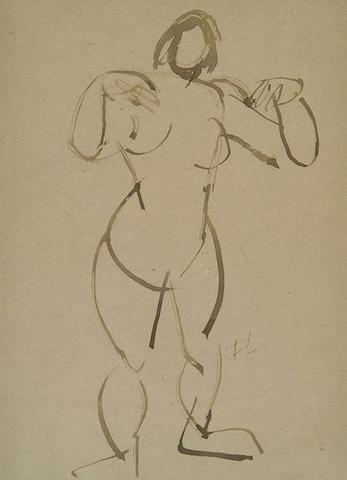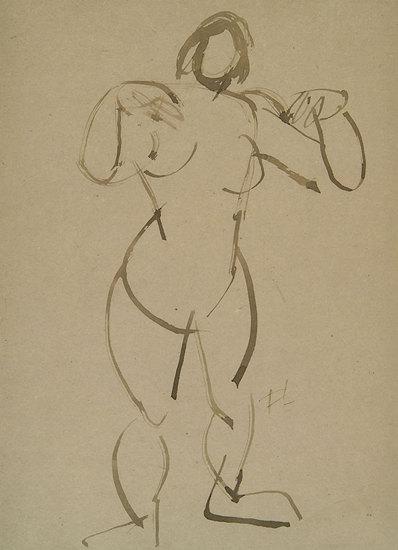
Nu debout aux bras levés
Fernand Léger (1881 Argentan - 1955 Gif-sur-Yvette)
1911
Plume et encre brune sur papier ; monogrammé « FL » ; 32,5 x 23,5 cm
Provenance :
collection Douglas Cooper ; Paris, Hôtel Drouot, 23 mai 2011 ; Paris, collection Le Polyptyque ; Paris, collection privée.
Exposition :
Douglas Cooper et les maîtres du Cubisme (Bâle, Kunstmuseum, 1987-1988 et Londres, Tate Gallery, 1988) ; Picasso, Braque, Léger, Gris : Douglas Cooper collecting Cubism (Houston, Museum of Fine Arts, 1990) ; Fernand Léger, gouaches, aquarelles et dessins (Paris, galerie Berggruen, 1996).
Ce dessin de 1911 témoigne de ce que le cubisme naissant doit à Cézanne d’un côté, à la sculpture « primitive » et à l’art « nègre » de l’autre.
Il s’inscrit plus particulièrement dans la lignée de la Femme nue debout de Cézanne en 1898-1899 (collection privée) et de certains des dessins de Picasso préparatoires aux Demoiselles d’Avignon en 1907 (New York, Museum of Modern Art). Ce n’est pas un hasard s’il a longtemps appartenu à Douglas Cooper (1911-1984), grand collectionneur et historien du cubisme, proche de Léger comme de Picasso.
Fernand Léger vint à la peinture moderne après la visite, en 1907, de la rétrospective Cézanne au Salon d’Automne. Installant son atelier à la Ruche, dans le quartier du Montparnasse, il se lie d’amitié avec Delaunay et rencontre Braque et Picasso par l’entremise de leur galeriste commun, Daniel Kahnweiler, chez lequel il fera sa première exposition personnelle en 1912.
Mais alors que Braque et Picasso s’orientent très vite vers le cubisme « analytique », Delaunay se fera le chantre de la couleur, et Léger celui des volumes. On le voit bien ici, où la ligne discontinue, mais parfaitement articulée, celle que Cézanne traçait autour de ses baigneurs et baigneuses, évoque finalement une sculpture, une idole primitive, une représentation de la force brute, plus qu’un simple dessin. On retrouvera évidemment certains de ces traits – le cerne des figures, l’articulation des formes, l’idéalisation de la force – dans les œuvres de la maturité.
